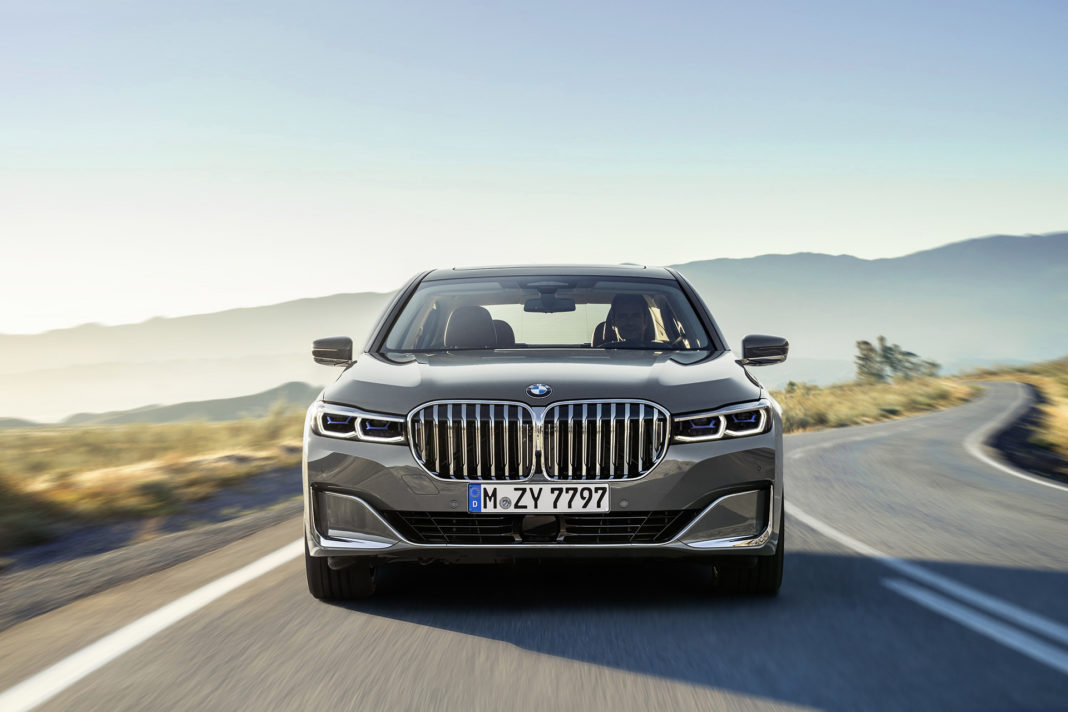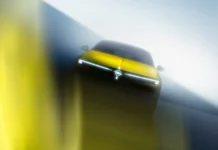With more technological advancements that deliver both outstanding comfort and handling, greater fuel efficiency and innovative driver assistance and connectivity, the new BMW 7 Series sets out its stall as the ultimate vehicle for luxurious driving pleasure.
In addition to striking exterior and interior design changes, BMW has updated the 7 Series engine range to include a new eight-cylinder engine and an in-line six-cylinder unit with plug-in hybrid system offering extended electric range.
The new BMW 7 Series will continue to be offered in standard and long wheelbase body variants. The longer version of the luxury saloon has a wheelbase extended by 14 centimetres over the standard car to 3,210 millimetres. Both variants have grown by 22 millimetres over their respective predecessors.
EXTERIOR DESIGN
The new BMW 7 Series incorporates an extensive design refresh at the front end that is now around 50mm taller at its foremost point. The traditional BMW kidney grille is now significantly larger and features active air flap control with adjustable vanes that only open when the need for cooling air is increased.
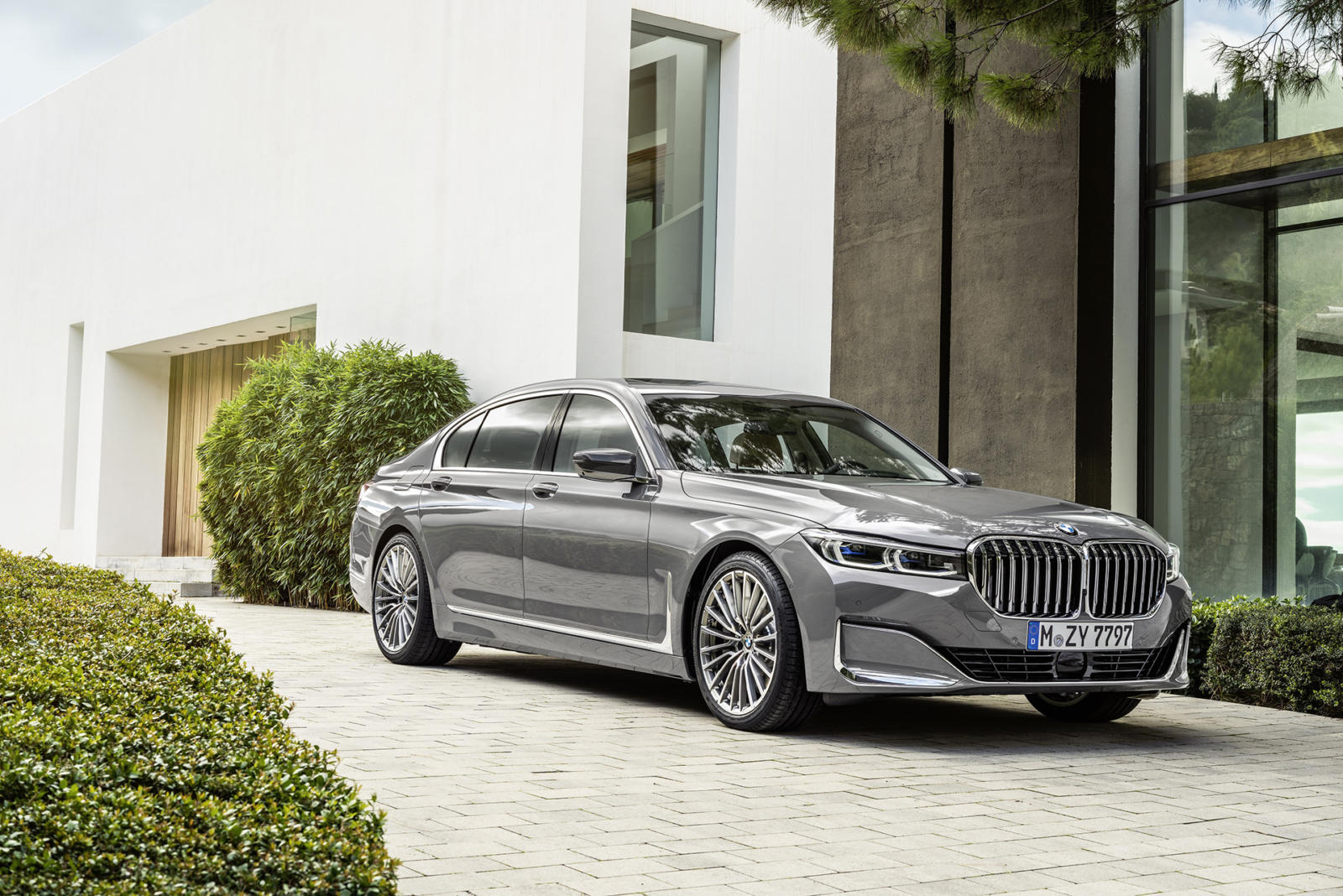 Wide-open air intakes for M Sport models have been updated and they feature C- shaped surrounds with integrated Air Curtains to underscore the positioning of air ducts at the outer edges of the front apron. The revisions also include aerodynamically optimised contouring of the front apron’s lower border.
Wide-open air intakes for M Sport models have been updated and they feature C- shaped surrounds with integrated Air Curtains to underscore the positioning of air ducts at the outer edges of the front apron. The revisions also include aerodynamically optimised contouring of the front apron’s lower border.
With long wheelbase and short overhangs, a flowing roofline and the Hofmeister kink (the upturned line at the trailing edge of the side window graphic), the new BMW 7 Series has all the hallmark BMW design cues.
Exterior mirrors attached to the window are surrounded by a thin stalk to further improve aerodynamics and the front side panels have been treated to a thorough redesign, too.
The new BMW 7 Series features new Air Breathers that optimise the flow of air through the wheel arches, helping to reduce turbulence. Air outlets that are integrated into the side panels now extend much further upwards and their trim strips form a 90-degree angle with the side trim elements.
The Air Breathers on either side of the car provide the starting point for a horizontal trim strip that runs above the side skirts and now reaches into the rear apron, both in standard form and when the M Sport trim level is specified. The M Sport model also includes side skirts.
At the rear of the new BMW 7 Series the outer sections of the rear apron adopt the design language used for the air intake trim in the front apron. The exhaust system’s tailpipes are edged in what are now wider chrome surrounds and are integrated flush into the lower section of the rear apron.
The three-dimensional rear lights of the new BMW 7 Series are around 35 millimetres slimmer than on the outgoing car. Other new features include a slim light strip sited below the chrome bar, which extends across the full width of the tailgate and connects the rear lights with each other.
NEW PAINT FINISHES AND LIGHT-ALLOY WHEELS
The selection of exterior paint finishes available for the new BMW 7 Series comprises one non-metallic and 12 metallic finishes. Customers can also choose from four BMW Individual options and countless BMW Individual special paint finishes.
Depending on the model variant, the new BMW 7 Series comes as standard with18- inch light-alloy wheels. Additional light-alloy wheels in 18-inch to 21-inch formats are included on the options list and in the Original BMW Accessories range. New to the line-up are 20-inch light-alloy wheels in multi-spoke and star-spoke design, and 21-inch light-alloy wheels in W-spoke design.
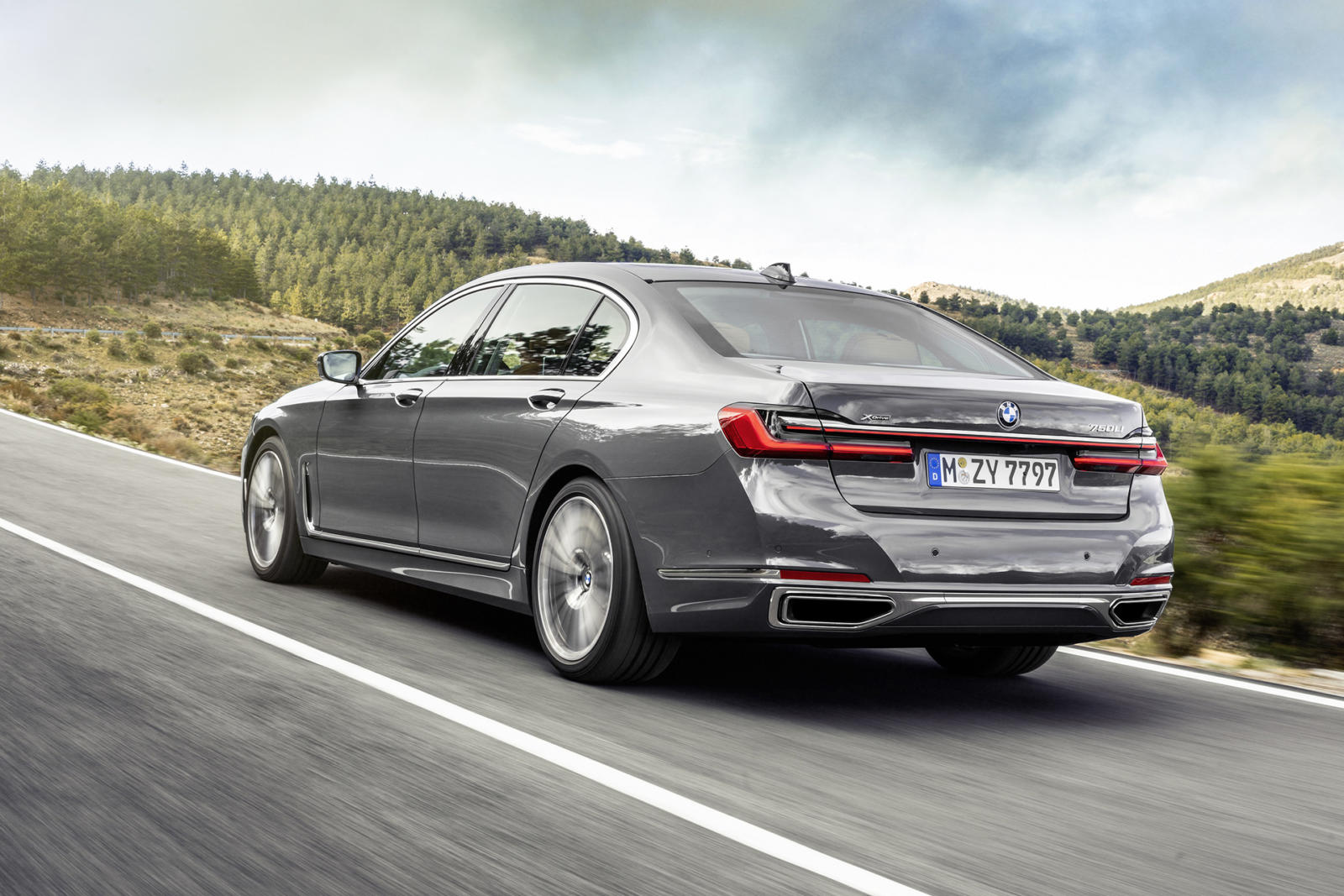 LIGHTWEIGHT AND OPTIMISED AERODYNAMICS
LIGHTWEIGHT AND OPTIMISED AERODYNAMICS
The body structure comprises a material mix of high-strength steels, aluminium and carbon fibre-reinforced plastic (CFRP). The Carbon Core used for the passenger cell makes a major contribution not only to the high level of safety, but also to the handling capabilities.
A significant role in the optimisation of the vehicle’s aerodynamic characteristics is played by the active air flap control system along with Air Curtains and Air Breathers. Air drag is also reduced by the cladding covering almost the entire underbody.
The level of tyre noise reaching the rear compartment has been reduced by the optimised shielding of the rear wheel arches. A further reduction in the interior noise level is through sound insulation elements in the B-pillar area, the seatbelt outlet covers and the rear seat backrest.
Laminated glass with an increased thickness of 5.1 millimetres is now used not only for the windscreen, but also for the side windows and rear window too.
INTERIOR FEATURES
The new BMW 7 Series models are equipped as standard with a hands-free phone system including wireless charging. Previously situated under the centre console armrest, the tray for smartphones that support wireless charging is now positioned immediately in front of the cupholders. LED ambient lighting with a choice of six colours is available as standard.
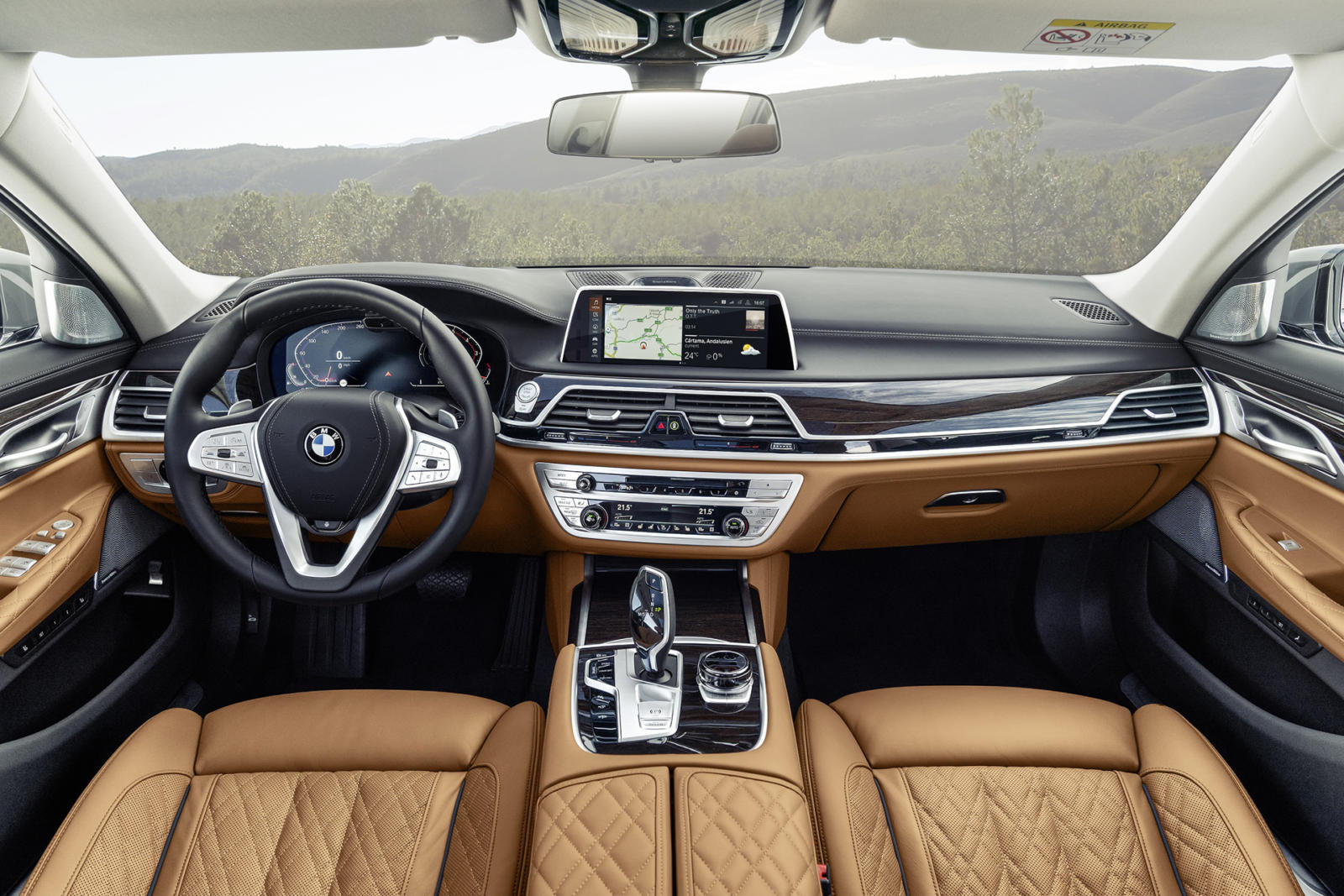 The rear-seat entertainment system comprises two 10-inch full-HD displays complete with a Blu-ray player. The system allows users to access the entertainment, navigation and online functions of the vehicle from the rear seats.
The rear-seat entertainment system comprises two 10-inch full-HD displays complete with a Blu-ray player. The system allows users to access the entertainment, navigation and online functions of the vehicle from the rear seats.
The viewing angle of the screens, which now have touchscreen functionality, can be adjusted in accordance with the rear seat passengers’ existing seat position.
The new BMW 7 Series also includes the latest version of the BMW Touch Command unit. This removable tablet with a 7-inch screen can be used from any seat and even outside the vehicle.
It lets the occupants operate comfort functions such as seat adjustment, interior lighting and climate control, as well as the infotainment, navigation and communication systems. It can also be used to play external audio and video files.
The graphics and menu system of the BMW Touch Command tablet and the rear-seat entertainment Experience displays are now aligned with the software features and functionality of BMW Operating System 7.0, which is also used for the all-digital displays of the instrument cluster and Control Display.
ENGINE RANGE
The new BMW 7 Series is available with petrol and diesel engines using six, eight and 12 cylinders as well as a plug-in hybrid drive system offering an increased electric range, enhanced performance and lower consumption.
The eight-speed Steptronic transmission fitted as standard on all model variants has also undergone further improvement as has the BMW xDrive intelligent all-wheel-drive system that can be combined not just with the petrol and diesel engines but with the hybrid drive too.
Spearheading the line-up of engines for the new BMW 7 Series is the 12-cylinder petrol engine. This 6.6-litre 585hp unit with a peak torque of 850Nm is used to power the BMW M760Li xDrive.
Top speed is electronically limited to 250km/h. The benchmark zero to 100km/h sprint can be achieved in 3.8 seconds* while CO2 emissions are at 282g/km*.
The buttons of the Driving Experience Control switch can now be used to select an additional SPORT+ mode in the new BMW M760Li xDrive that activates a track-geared vehicle set-up including linear throttle response, direct, sporty, undamped engine response and a particularly vocal soundtrack.
The new BMW M760Li xDrive V12 Excellence also offers a COMFORT+ mode for a more relaxed driving experience.
The BMW 750i xDrive features an uprated 4.4-litre V8 that offers a maximum power output of 530hp – 80hp more than the engine it replaces. Peak torque is up by 100Nm to 750Nm. The flap-controlled M Sport exhaust system fitted as standard produces an exhilarating soundtrack to match the power delivery.
The entry level petrol engine comes in the form of the BMW 740i and 740Li. With a power output of 340hp and a peak torque of 450Nm, the 740i and the 740Li accelerates from 5.5 and 5.6 seconds, respectively.
The choice of models equipped with BMW eDrive technology now comprise the BMW 745e and the BMW 745Le xDrive. The integration of a six-cylinder in-line engine into the plug-in hybrid system, a more advanced high-voltage battery, more power and torque, plus improved figures for electric range, consumption and CO2 emissions chart the progress that has been made compared with the outgoing models.
The plug-in hybrid models that will be available at the launch of the new BMW 7 Series in spring 2019 feature a six-cylinder in-line petrol engine from the current BMW Efficient Dynamics family of power units with maximum output of 286hp and an electric motor with a rated output of 113hp and a peak torque of 265Nm.
With the Driving Experience Control switch set to SPORT mode, total power of 394hp is available, while the maximum combined torque for the plug-in hybrid variants in the new BMW 7 Series is up to 600Nm.
The new plug-in hybrid drive technology enables the BMW 745e and BMW 745Le xDrive models to record zero to 100km/h times of between 5.3 and 5.1 seconds while achieving an electric-only range of between 50 to 58kms*.
The speed threshold for all- electric driving has also increased to 110km/h. The combined fuel consumption figures for the plug-in hybrid luxury versions are between 2.2 – 2.6 l/100 km*. The CO2
emissions produced when burning fuel average between 48 and 52g/km*.
The new BMW 7 Series also offers a trio of 3.0-litre six-cylinder in-line diesel engines delivering 265hp with a peak torque of 620Nm.
A latest-generation eight-speed Steptronic transmission is featured in the BMW xDrive all-wheel-drive versions while the BMW 745e and BMW 745Le xDrive are equipped with a hybrid-specific variant of the eight-speed Steptronic transmission.
For the first time, the plug-in hybrid variants are available with the standard of an eight-speed Steptronic Sport transmission, offering even quicker gear changes and the benefit of shift paddles on the steering wheel.
The Launch Control function is another feature of the eight-speed Steptronic Sport transmission, which comes as standard on the new BMW M760Li xDrive.
Intelligent networking enables the eight-speed Steptronic transmission’s controller to also factor in navigation data when selecting the best shift strategy. As a result unnecessary gear shifts can be eliminated and optimum use can be made of the engine braking effect when approaching a junction.
The drive system’s networking with both the navigation system and the cameras and radar sensors likewise serves to maximise the efficiency-enhancing effect of the Auto Start Stop and coasting functions.
In this way, inefficient engine shutdown when stopping only briefly can be prevented, while the coasting function is only activated if the route topography and traffic situation mean it won’t compromise either comfort or performance.
BMW xDrive intelligent all-wheel drive comes as standard on the V12 and V8 petrol models and the two most powerful diesel models, while it is available as an option for the BMW 730d.
DRIVING EXPERIENCE CONTROL FOR IMPROVED COMFORT AND HANDLING
The driver can use the Driving Experience Control switch buttons to select a set-up option to suit the situation and configure that set-up individually. In ADAPTIVE mode, the overall set-up adapts automatically to the driving style and situation.
It responds to movements of the accelerator pedal and steering wheel, the position of the gear selector lever and data from the navigation system to instantly select the right set-up as the car moves from city driving to the open road.
All variants of the new BMW 7 Series feature, as standard, adaptive suspension including electronically controlled dampers and two-axle air suspension with automatic self-levelling.
Plus, the Driving Experience Control switch can be used to activate a range of damper settings to shift the emphasis of the driving experience further towards either comfort or sportiness.
The ride-height can be adjusted manually. For example, it can be raised by 20 millimetres at the touch of a button on bumpy road surfaces or steeply angled ramps on the way into garages.
The new BMW 7 Series also features the optional Integral Active Steering system. This technology allows the driver to execute low-speed manoeuvres with only small steering inputs and without having to change their grip on the steering wheel.
At higher speeds, meanwhile, the car’s responses to movements of the wheel are less pronounced, improving both directional stability when driving in a straight line and precision on the way into corners.
By turning the rear wheels in either the same direction as or the opposite direction to the front ones, depending on the road speed, the system also makes the BMW 7 Series nimbler in city driving and increases its agility and tracking through corners.
At low speeds, the rear wheels turn in the opposite direction to the front wheels, easing the car’s manoeuvrability and significantly reducing its turning circle.
By contrast, at higher speeds, the rear wheels follow the same direction as the front wheels, allowing the car to follow the course set by the driver even more quickly and accurately.
Customers can also choose the Executive Drive Pro chassis system that is available for all model variants apart from the BMW 745e and BMW 745Le xDrive. This active chassis control technology reduces rolling movements at the front and rear axle to improve comfort and enhance handling.
Executive Drive Pro also includes an anticipatory chassis control function. The advance information for regulating the combination of chassis systems is gleaned from driving style analysis readings, data from the navigation system and a stereo camera, and significantly increases ride comfort and active safety.
The Executive Drive Pro system and Integral Active Steering are part of standard specification for the new BMW M760Li xDrive. The 12-cylinder model is also fitted as standard with 20-inch M light-alloy wheels in twinspoke design.
They team up with mixed tyres in 245/40 R20 format at the front axle and 275/35 R20 at the rear. The new BMW M760Li xDrive can also be ordered as standard with runflat tyres and additional 20-inch light-alloy wheels.
DRIVER ASSISTANCE SYSTEMS
Parking Assistant Plus comes as standard in Ireland and aids parallel parking and Active Park Distance Control (PDC). This pack also features Reversing Assistant, which helps the driver to exit parking spots or manoeuvre when space is limited.
This system is the only one of its kind in this segment and offers automated reversing in confined spaces. This is done by storing the steering movements made during the vehicle’s last forward manoeuvre when travelling at speeds up to 45km/h.
The system is then able to reverse the vehicle for distances of up to 50 metres by steering it along exactly the same line it took when moving forward. All the driver has to do is operate the accelerator and brake pedals and monitor the vehicle’s surroundings.
Parking Assistant Plus also provides an all-round view of the car and its surroundings from different perspectives in the Control Display. The Remote 3D View function additionally gives drivers the ability to call up a three-dimensional live image of their vehicle and its immediate vicinity on their smartphone.
Cruise Control with braking function also comes as standard on the new BMW 7 Series, while Active Cruise Control with Stop & Go function can be added as an option. With the latter system the driver can simply press a button to import the speed restrictions detected by the Speed Limit Info system as the set cruise control speed, either exactly or with a pre-programmed adjustment of up to 15km/h.
The distance information that appears in the optional Head-Up Display is another feature of the Active Cruise Control system with Stop & Go function. This function helps the driver to keep at a predetermined distance from the vehicle ahead when cruise and distance control are not activated.
The optional Driving Assistant Professional package adds the Steering and lane control assistant including Traffic Jam Assist, as well as the Lane Keeping Assistant with active side collision protection.
The Active Cruise Control system included as part of the Driving Assistant Professional package is capable of adapting the speed to the planned route with the help of navigation data. As a result, the vehicle automatically slows to an appropriate speed ahead of bends, junctions or roundabouts.
The traffic sign recognition system also makes use of the navigation data to glean information on upcoming speed restrictions so that they can be taken into consideration in advance.
Further Driving Assistant Professional features include a Cross Traffic Alert system and the Priority warning and Wrong-way warning systems. Another of the package’s components is the evasion aid, which can help avoid collisions with vehicles or pedestrians suddenly appearing in the driver’s path.
As soon as an evasive manoeuvre corresponding to such a scenario is detected, the system helps the driver direct the vehicle into a clear adjacent lane with steering inputs.
The options list includes Remote Controlled Parking that enables the driver to trigger the process of entering and exiting parking spaces from outside the car using the BMW Display Key.
The BMW 7 Series can therefore be manoeuvred forwards into enclosed parking spaces or garages and reversed out of them again. During these manoeuvres, the car’s acceleration and braking is monitored by the sensors of the driver assistance systems and supervised by the driver.
Standard specification for the new BMW 7 Series includes the BMW Intelligent Personal Assistant – an intelligent, digital helper who responds to the prompt “Hey BMW”. This technology learns routines, habits and preferences to help the driver get the best out of the in-car functionality such as the seat heating or the places they navigate to.
Drivers can also give the Personal Assistant a name for even greater individuality and personality. The Assistant is familiar with the vehicle’s functions and is able to operate them as required.
Saying “Hey BMW, I’m cold” will prompt the BMW Intelligent Personal Assistant to adjust the temperature inside the car accordingly.
It can even attend to the driver’s sense of wellbeing by providing vitality and relaxation programmes and can activate air conditioning, seat massage, fragrance or music to refresh or relax the driver while they are at the wheel.
The selected programme runs for a duration of three minutes. The new BMW 7 Series additionally offers three different Experience Modes for the interior to choose from, which are geared to suit the driver’s current mood and can be activated for as long as desired.
CONNECTED NAVIGATION WITH NEW DIGITAL SERVICES
“Connected Navigation” encompasses a number of digital services to improve and enhance route planning. In future, drivers of the new BMW 7 Series will be able to send destinations from various apps straight to their car’s navigation system.
The key destinations will be stored in BMW Connected and synchronised with the car, so that the most important addresses can be accessed from any device at any time. One particularly helpful new feature is the Parking Space Assistant, which proposes various parking options to the driver in good time before the destination is reached.
This service includes providing information on the nearest multi-storey car park as well as proposing routes offering a particularly good chance of finding a parking spot close to the destination.
THE BMW OPERATING SYSTEM 7.0 DISPLAY AND CONTROL CONCEPT
The newly designed screen grouping – comprising the instrument cluster and Control Display, together with the inclusion of new functions – enables intuitive operation to be taken to the next level in the new BMW 7 Series, while helping drivers to concentrate even more effectively on the road ahead.
The standard BMW Live Cockpit Professional comprises a fully digital, high-resolution instrument cluster behind the steering wheel with a screen diagonal of 12.3-inches and a Control Display measuring 10.25-inches across. This package of equipment also features an adaptive navigation system and a hard-drive-based multimedia system with up to 320 GB of memory.
The BMW Operating System 7.0 boasts all-digital displays and is geared more closely to the driver’s personal needs. The redesigned information display in the centre of the instrument cluster now leaves enough room for an excerpt from the navigation map, for instance.
In the main menu on the Control Display, the driver can create and individually configure up to ten pages, each showing two to four pads (tiles) with live content. Both the content and the graphics are personalised to an even greater degree, as illustrated by the vehicle mock-up that matches the actual model and body colour.
The Control Display graphics adapt depending on the operating method and the voice control system based on natural language understanding is better than ever.
Depending on the situation, the driver can choose from the familiar iDrive Controller, the steering wheel controls, touch control, voice control or gesture control.
New or existing services can be added at any time by downloading additional digital services from the ConnectedDrive Store and the installing them in their car. Services can be booked in this way for periods of three months, one year or three years.
Also, the Remote Software Upgrade feature keeps the new BMW 7 Series up to date with the latest software. All updates can be imported over the air, either on a smartphone via BMW Connected or directly into the car using its built-in SIM card.
Installation is much like a smartphone update. The content of the upgrades can vary, from new software services to improved vehicle functions.
The BMW 7 Series is on sale from 13 April 2019 with prices starting from €96, 160 RRP.
* Fuel consumption, CO2 emissions and power consumption are provisional, and were measured using the methods required according to Regulation (EC) 2007/715 as amended. The information is based on a vehicle with basic equipment in Germany; ranges take into account differences in wheel and tyre size selected as well as optional equipment and can change during configuration.
The information has already been calculated based on the new WLTP test cycle and adapted to NEDC for comparison purposes. In these vehicles, different figures than those published here may apply for the assessment of taxes and other vehicle-related duties which are (also) based on CO2 emissions.
For further details of the official fuel consumption figures and the official specific CO2 emissions of new cars, please refer to the “Manual on the fuel consumption, CO2 emissions and power consumption of new cars” available free of charge at all sales outlets, from Deutsche Automobil Treuhand GmbH (DAT), Hellmuth-Hirth-Str. 1, 73760 Ostfildern-Scharnhausen and at https://www.dat.de/co2/.

